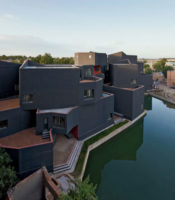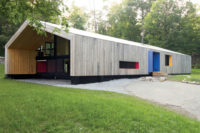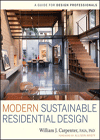While sipping beers on their porches in downtown Phoenix in 2003, neighbors Chris Nieto and Joe Herzog, AIA, began brewing up the idea to start their own architecture firm. At the time, Nieto was running his family’s contracting company, while Herzog was working for architect Wendell Burnette, following a four-year stint with Will Bruder. “We had a lot of evening conversations about how we wanted to change our city, and our world for that matter,” says Herzog.
Those casual chats morphed into a serious venture. In 2004, the duo founded Merzproject — now one of the most popular design studios in Phoenix. In short time, the firm has built a series of economical, sustainable, and urban projects and garnered several honors: Its Galleries at Turney (2007) was Arizona’s first project to earn LEED for Homes certification, for instance, and Hoover House was AIA Arizona’s Home of the Year in 2008. Moreover, The Arizona Republic recently named Nieto one of the state’s top entrepreneurs under the age of 35. (Nieto handles Merzproject’s business affairs, while Herzog is the creative force.) “I think we’re part of a new generation, and people are looking to us for design leadership,” says Herzog. “We’re now pushing into the establishment, and we’re pushing the dialogue.”
That dialogue often centers on curbing sprawl. With its abundance of tract housing, golf courses, and swimming pools, Phoenix can be a tough place to campaign for a dense urban fabric. Herzog, an Indiana native, started to take on this challenge while earning his M.Arch. degree at Arizona State University. For his thesis project, he proposed stitching together nodes of activity in the valley’s core. He called his scheme “[merz] Phoenix,” inspired by a word (merz) invented by the 20th-century German artist Kurt Schwitters to describe his collage-style paintings and sculptures. Herzog was particularly struck by Schwitters’s Merzbau, in which the artist transformed his own home into a giant collage, filling it with a bewildering array of objects. “He started to find connections between different pieces, literally taking a string to make the connections,” Herzog explains. “A web started to emerge, and new spaces started to form.”
Herzog’s own “merz” project won a graduate thesis award, and the idea of connectivity has continued to intrigue him, especially as it relates to urban renewal. His and Nieto’s firm, which now totals eight employees (two principals, four directors, and two designers), has completed a half-dozen projects within a six-block area in central Phoenix, including its own office, dubbed The Link. Housed in a refurbished 1950s masonry building, the studio is within walking distance of a new light-rail stop, along with an art museum, library, shops, and restaurants.
Merzproject also has a talent, perhaps even a hunger, for handling constraints. Consider After Hours, a 7,500-square-foot, mixed-use building that required some tricky maneuvers due to a 30-foot and two-story height restriction. After discovering that the city measured building height at the median point of the street-facing elevation, the architects devised a single-sloped roof that meets the requirement, yet peaks at 37 feet on one side. And they scooted around the two-story rule by inserting a mezzanine. “There’s nothing you can’t figure your way out of,” Herzog says. “If you set a project in motion with a strong idea, it’s easy to resolve problems as you go forward.” He adds that their studio is highly collaborative and egalitarian, noting that clients will ask who conceived a specific feature, “and we don’t even know.”
While Phoenix has served as a fertile testing ground, Merzproject has set its sights much farther out: It’s submitting proposals for projects across the globe, focusing on civic work in particular. “We are open to the world,” says Nieto. Indeed, one gets the sense that this eager young firm is just beginning to weave an expansive web.






















